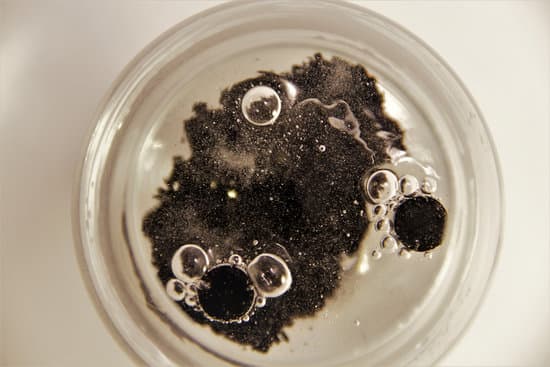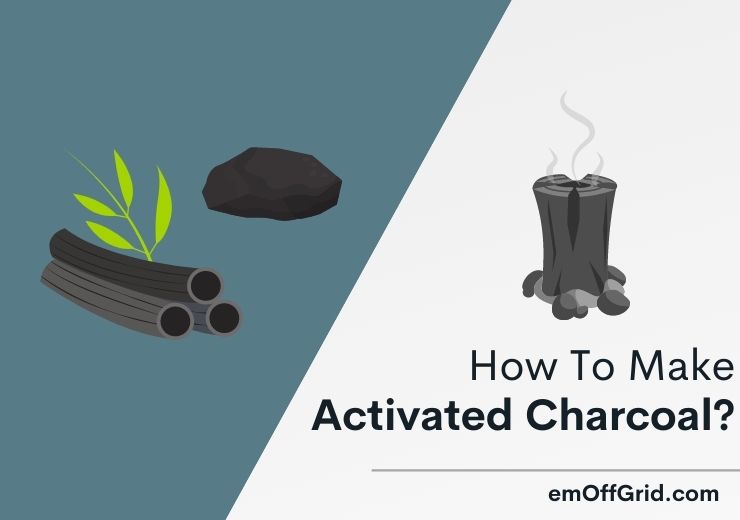Activated charcoal has many uses both at home and in the hospitals as a remedy to various conditions. Making activated charcoal at home is easy, and that is what this article will be all about.
We will discuss how to make activated charcoal in 8 steps. The substance can be used in water filtration, teeth whitening, oral health, and many other uses.
Activated charcoal has absorbent property, making it multipurpose. Its porous texture has a negative charge that attracts positive charges from toxins.
Contents
What is Activated Charcoal?

Let us start by stating that activated charcoal is not the same as the charcoal we use for cooking, warming the house, or barbeques.
They are both made from the same base material but have different properties.
Activated charcoal is a fine, odorless, black powder made by chemical-treating powdered charcoal and heating under high temperatures.
That action reduces the sizes of the particles while increasing the surface area. It, therefore, makes activated charcoal have high absorbent properties.
Activated charcoal is often used to prevent food poisoning as it binds with the toxins, preventing them from being absorbed into the body.
Activated charcoal is neither digested nor absorbed in the digestive system. As a result, activated charcoal is mainly used in hospitals, however, you can also make it for home use.
Materials and Tools To Make Activated Charcoal
Making your own activated charcoal is way much more cost-effective than buying the commercial one.
It mainly involves mixing the ground charcoal with calcium chloride and then heating it under high temperatures. To do that, you will need some materials and tools.
Collecting Charcoal
You can buy charcoal from nearby stores or online on Amazon. Alternatively, you can make the project 100% DIY by making your own charcoal.
We have posted an article on How To Make Charcoal At Home. Use it as your reference if you opt to make the charcoal blocks by yourself.
Buying charcoal from a store will be more expensive. We, therefore, suggest making it from blocks of wood you can find around.
It is a straightforward process. Just follow the steps provided in the link above to accomplish the task.
A pound of activated charcoal will cost you about $12-$15 while making it yourself can cost you under five dollars. Read through this article to learn how to make it the cheaper way.
Ingredients and Tools
You will need the following materials and tools to successfully make activated charcoal:
- Charcoal
- Calcium Chloride (Pickle Crisp)- Lemon Juice Can Be Used as an Alternative
- Glass Jar/Container w/Tight-Fitting Lid (Avoid Aluminum)
- Water
- Measuring Cup
- Cheesecloth or White Sheet
- Mortar and Pestle
- Fine-Mesh Screen
- Cookie Sheet/Flat Pan
- Source of Heat
8 Steps To Make Activated Charcoal

To proceed with the activated charcoal-making process, you need charcoal and calcium chloride or lemon juice.
You also need a source of heat. With everything ready, you can make activated charcoal in 8 steps as listed below:
- Wash the charcoal and let it dry.
- Grind the charcoal into a fine powder.
- Screen your charcoal.
- Activate the carbon.
- Mix and incubate the mixture for 24 hours.
- Drain the mixture.
- Cook the charcoal to activate it.
- Allow the mixture to dry out thoroughly.
Each step should be carried out diligently and cautiously, following one after the other. The following are the details:
Wash The Charcoal And Let It Dry
If you made your own charcoal, give it time to cool before proceeding. A commercially bought charcoal should be already cool.
Transfer the charcoal into another container, where you will wash it with plenty of clean water.
This process removes ashes and other impurities. Once done, drain the charcoal and let it dry completely before proceeding with the next step.
Grind The Charcoal Into A Fine Powder

Transfer the cleaned and dried charcoal to a mortar and use a pestle to grind it into a fine powder.
Alternatively, you can reduce the charcoal into powder by crushing it in a durable bag with a hammer or a tenderizing mallet.
Screening Your Charcoal
Regardless of how fine you grind your charcoal, you will still end up with oversized particles that should be screened out.
Using the fine-mesh screen or strainer over a flat pan, sieve the ground charcoal. You will end up with a fine charcoal powder on the pan.
Discard the large pieces on the screen or continue grinding them further. Air the resulting carbon powder to ensure it is completely drained of water and proceed to the next step.
Activating The Carbon

This is the step where we will be turning charcoal powder into activated charcoal. You can do it using calcium chloride or lemon juice. Proceed as follows:
Add A Combination Of Calcium Chloride And Water
Mix water and calcium chloride in a ratio of 3 to 1. That is to say, one part of calcium chloride in three parts of water.
You should also be careful when carrying out this step because calcium chloride is very corrosive.
Wear hand gloves and pour calcium chloride into a container with water and not vice versa. You can buy calcium chloride from a nearby chemical retail shop.
Use A Lemon/Bleach
If you cannot find calcium chloride, you can consider lemon juice as an alternative.
The process and quantities do not change. Mix water and lemon juice in the same ratio of 3:1 and scale it up to make as much activated carbon as possible.
Mix And Incubate The Mixture For 24 Hours
Transfer the dry charcoal powder into a glass or stainless-steel jar and add the solution from the previous step.
It can be that of calcium chloride or lemon juice, depending on what you used. The solution is added to the charcoal powder in small quantities while continuously stirring.
That process stops when you have achieved a uniform paste.
Cover the container and let the mixture incubate for at least 24 hours.
Drain The Mixture
Drain moisture from the mixture. This step should make charcoal wet but not saturated in the solution. After draining, proceed to heat treatment.
Cook The Charcoal To Activate It
Transfer the charcoal into a metal container or a cooking pan with a lid and heat it over medium to high heat for three hours. The charcoal will be activated by this heating process.
Allow The Mixture To Dry Out Thoroughly
Air-dry the activated charcoal or dry it over an oven at a relatively low temperature for about 2-4 hours. Check it from time to time to ensure it is dry before transferring it to the storage container.
How To Use And Store Activated Charcoal

Before listing different uses of activated charcoal, let us first describe how it works.
The absorbent property of activated charcoal is harnessed to remove bad smells, bacteria, pollutants, and allergens from the air, water, and our bodies.
It also binds to gasses and particles, thereby neutralizing them.
You can use activated charcoal in the following ways:
- Purifying air around the home by wrapping the activated charcoal with linen and hanging it at the most appropriate spot.
- Making a water filter by putting activated charcoal in a sock and pouring water into the storage containers through it.
- Using activated charcoal to make a clay-charcoal facial masque that is effective in removing toxins and unblocking pores.
- Activated charcoal is effective in treating bloat by absorbing gas in the digestive tract. You can take it plain or in a solution of non-acidic juice.
- Making a face mask to maintain your respiratory health.
- As a food additive to enhance food color and taste. However, you should not be fond of doing this, given the side effects.
The formed activated charcoal has a high absorbent property. It should, therefore, be stored in a canning jar with an airtight lid.
Exposure to air or any other chemical will significantly degrade it as it can absorb whatever is in the air.
Alternatively, you can encapsulate the activated charcoal in gel caps and then keep them in a jar. That makes it even easier to take them when alleviating the effects of poison.
Types Of Commercial Activated Charcoal
Commercial activated charcoal is available in the market. You can buy these if you do not have time to make your own at home. The following are the common brands you can consider:
Anthony’s Activated Charcoal
Anthony’s Activated Charcoal
- Food Grade Ultra Fine Black Powder
- Batch Tested and Verified Gluten Free
- Derived from Select Natural Hardwood
This commercially activated charcoal is made from the selected hardwood and tested and proven to be gluten-free.
You can use it for making homemade facemasks, soaps, food additives, whitening teeth, water filtration, etc.
Organic Coconut Activated Charcoal
Organic Coconut Activated Charcoal Powder
- This product is Kosher
- This product is Halal.
- Complies with requirements for Activated Carbon under Food Chemicals Codex (FCC) and Drinking Water (NSF)
This activated charcoal is made from coconut charcoal powder and is considered food grade.
It is ideal for teeth whitening, facial scrubbing, soap making, and medical. Some people also prefer it for neutralizing odors, regulating the humidity, blocking static electricity, and many more.
Conclusion
Making activated charcoal at home is easy and effective, as seen in this article. We have also seen its many uses, however, you should not be fond of using it as a food additive.
We thank you for your time at the Em Offgrid. If you are satisfied with the information, we encourage you to share this article and explore our other posts.


